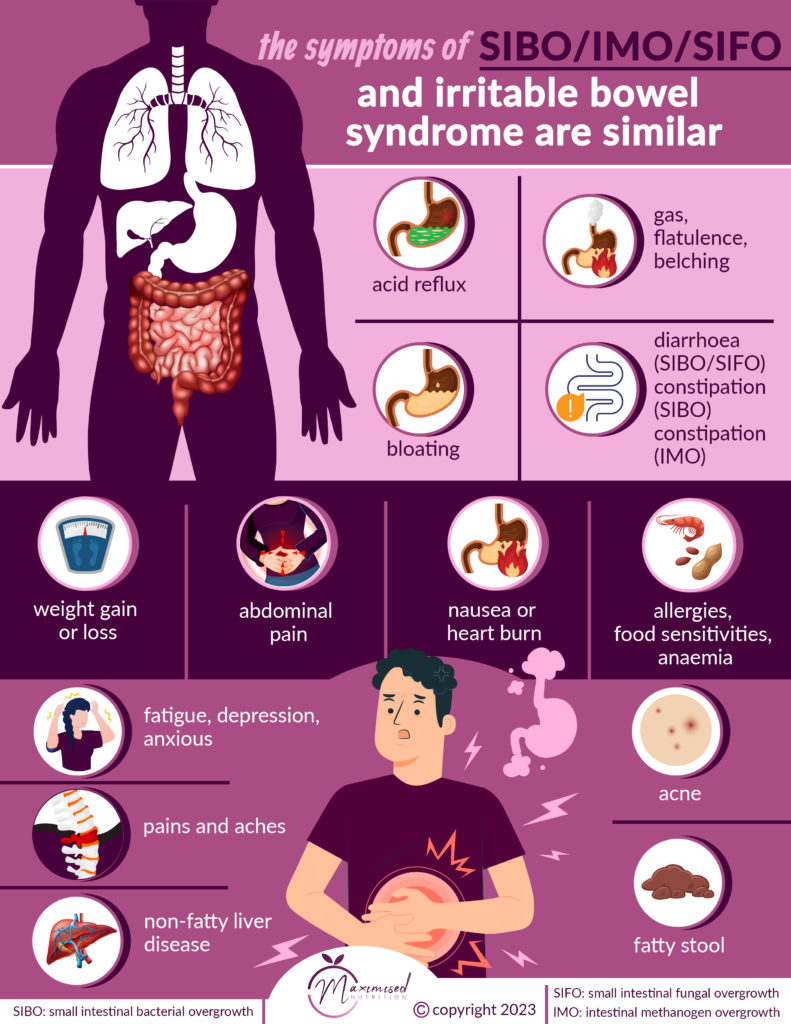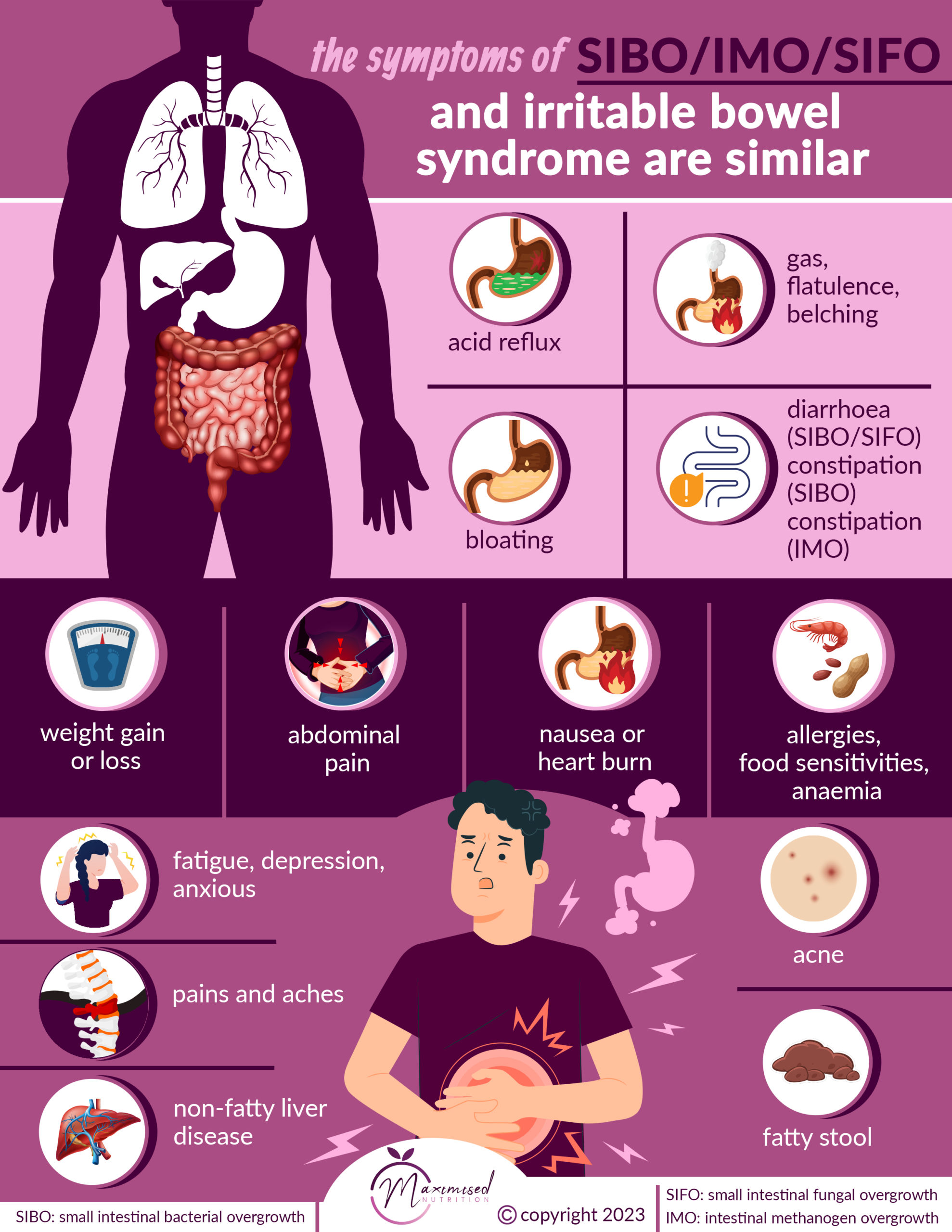SIBO or IMO or SIFO or Intestinal Dysbiosis As A Cause For IBS Symptoms

Summary
Have you tried FODMAP and it has not worked in managing your IBS? It may be Intestinal Dysbiosis (of which includes SIBO (Small Bacterial Intestinal Overgrowth) or IMO (Intestinal Methanogen Overgrowth or SIFO (Small Intestinal Fungal Overgrowth)).
A meta-analysis of 37 studies found that SIBO was in 36.7% of those that had IBS (irritable bowel syndrome).
IMO is now regarded as a separate identity from SIBO (replacing methane dominate SIBO). This is an overgrowth of archaea (micro-organisms) throughout the intestine (not just small intestine). The most dominant group of archaea present in IMO is Methanobrevibacter smithii.
SIFO is is characterized by the presence of excessive number of fungal organisams in the small intestine, associated with gastrointestinal symptoms.
You can get tested for SIBO Or IMO by Maximised Nutrition.
Part 1: What is Dysbiosis?
A healthy gut is made up of thousands of micro-organisms that exist in a harmonious relationship with each other. These organisms include bacteria, virus, fungus, yeast and archacia group of organisms.
Dysbiosis is the name given to the condition when there is an imbalance of these micro-organisms in your gut, either in numbers, variety or in places of distribution of these organisms in your gut, potentially leading to change in metabolism of your microbiome in your gut and its impact on health and well-being of the host.
Hydrogen Breath Testing can test for three of these dysbiotic stages (SIBO, IMO or large intestine dysbiosis).
Part 2: What is SIBO?
Small intestinal bacterial overgrowth, also known as “SIBO” defined
as overgrowth of bacteria in the small intestine, particularly bacteria that is
not found in that part of the bowel.
Causes of SIBO
SIBO can be a primary or secondary cause of symptoms experienced by patients. "Primary cause" means it causes the symptoms; "secondary cause" means it is a result of something else and leads to the overgrowth).
While we are not sure what causes SIBO, research shows the following factors may be involved:
- Low motility: normally, the intestine pushes food and bacteria through to the next part of the digestion. But with low motility, food and bacteria can remain longer in the small intestine, giving the bacteria chance to overgrow (secondary cause, so need to treat motility issues first).
- Anatomy of your bowel: your small intestine may be of an unusual shape. Thus it can make the food move through more slowly (as discussed above). Conditions include:
o Diverticulosis
o Surgical procedures like Roux-en-Y
o Scar tissue from radiation or surgery
o Injury to your small intestine
o Blockages in the GI tract
- Medical conditions such as diabetes, lupus, weakened immune system, or inflammatory bowel disease such as Crohns or ulcerative colitis or coeliac disease.
- Medications such as proton pump inhibitors to slow down acid in your stomach, antibiotics or narcotics.
- use of antibiotics multiple times over the years.
- food poisoning. It has been shown that one in nine person with food poisoning will develop IBS.
What happens with SIBO?
Since there is bacteria overgrowth and even bacteria from one part of the gut may migrate to the small intestine, the bacteria interferes with normal digestion and absorption of food.
The toxins and by-products produced by these bacteria can also damage the lining of the small bowel.
Thus the lining may not provide the barrier between the gut and blood vessels and immune system under the gut lining. So the food particles and toxins can get through into your system: thus causing food allergies, immune issues.
Some bacteria can producing toxins and these can get into the blood stream (causing more issues potentially).
Due to poor digestion and absorption, there can be ongoing nutrient malabsorption such as iron, Vitamin B12, fat soluble vitamins such as vitamin A, D, E, K. There can also be fat malabsorption.
Part 2: What is IMO?
Methane was thought to be a gas that was produced as a bi-product of metabolism and passed through flatus. However, it recently it has been found to be produced in greater quantities in those suffering from constipation or IBS-constipation. The organism responsible for the production of methane belongs to another group of microbiome called Archaea. In humans, the archaea species is Methaninobrevibacter smithii. Methanogens are present in healthy humans all the time, thus humans produce methane all the time. However, it is when the amount of methane produced becomes high, it is then it can become problematic and cause health related issues such as constipation, slow gut motility.
Part 3: What is SIFO?
Small intestinal fungal overgrowth (SIFO) is characterized by presence of excessive number of fungal organisms in the small intestine associated with gastrointestinal symptoms.
While Candidiasis has been known to cause gastrointestinal symptoms in those with compromised immune system, two studies have shown that around 26% and 25.3% of healthy (non-immunocompromised) patients with unexplained gastrointestinal symptoms had SIFO.
The most common symptoms of SIFO are belching, bloating, indigestion, nausea, diarrhoea and gas.
Part 4: What is Intestinal Dysbiosis?
A healthy gut has more than 1000 species of bacteria and other microbiome. A fine balance exists between the beneficial (known as commensal bacteria) and pathogenic bacteria. This balance helps the microbiome to keep a healthy gut barrier, take part in digestive process and even be part of communication between gut and other organs including the brain.
Dysbiosis is the term given to the condition when the microbiome in the gut becomes unbalanced or there is change in the function the microbiome does or if there is a change in way the microbiome is distributed towards the gut.
Dysbiosis is thought to a causal factor in development of many diseases including cancer, diabetes, obesity, inflammatory bowel disease and autism.
How to Test for SIBO/IMO/Large Intestine Dysbiosis
There are two ways to test for SIBO/IMO/Large Intestine Dysbiosis:
- Small Intestine Aspirate and Culture: During an endoscopy procedure, your specialist takes a sample of the aspirate from the small intestine and sends it to the lab for analysis of the aspirate where the lab can test to see if there is bacteria overgrowth. This is an invasive procedure. It has been assumed that aspirate is the gold standard. It is not really as the short coming of using an aspirate is that the aspirate only takes 5cm to 6cm of the top end of the small intestine. The length of the intestine is around 60cm. Also the endoscope used is also cross contaminated with other microbiome as it enters the small bowel.
- Breath test: This is simple and non-invasive way of testing SIBO. A glucose or lactulose solution drank by the patient. As the liquid travels down the intestinal passage, the bacteria metabolise it and release gases: methane and hydrogen. These gas get into your blood and then to your lungs where they are exhaled. A breath test machine can analyse the presence of this in the collected sample and determine the likelihood of SIBO/IMO in a client.
Lactulose breath test results have a high level of correlation with the short gun sequencing of DNA. This is when the long slices of a microbiome's DNA is sliced and analysed. This method can get information to what the strain of bacteria is.
Red Flags
However, before you undertake a breath-test, it is crucial to consider other factors that may be causing you these symptoms. These factors including having inflammatory bowel disease such as Crohn’s Disease, Ulcerative Collits or even cancer.
Please see your GP and even get a specialist referral to a gastroenterologist (through your GP) if these red flags are present:
· Symptoms begin at age 50 or older
· Change in symptoms
· Progression of symptoms
· Unexplained weight loss
· Blood in the stool
· Diarrhea that interferes with sleep
· Abnormal physical examination (such as a mass) or lab result (such as iron deficiency anemia
Treatment may include adjusting medications. For example, people with Crohns Disease can have IBS or SIBO. So the medications for these need to be adjusted by your GP/Specialist to avoid further problems.
SIBO/IMO/Large Intestine Dysbiosis Testing Provided By Maximised Nutrition
Maximised Nutrition provides a home based self test option for those needing to do the SIBO/IMO breath test. See section on "Preparing for Hydrogen Methane Breath Test".
References
Erdogen A, Rao S. Small Intestinal Fungal Overgrowth Current Gastroenterol Rep (2015)17:16
Konstantinos Triantafyllou, Christopher Chang and Mark Pimentel: Methanogens, Methane and Gastrointestinal Motility. J Neurogastroenterol Motil 2014; 20(1): 31-40 https://doi.org/10.5056/jnm.2014.20.1.E
Pimental et al: ACG Clinical Guideline: Small Intestinal Bacterial Overgrowth. The American Journal of Gastroenterology 2020: 115(2):p 165-178
DeGruttola A et al: Current understanding of dysbiosis in disease in human and animal model . Inflamm Bowel Dis. 2016 May; 22(5): 1137–1150 (https://www.ncbi.nlm.nih.gov/pmc/articles/PMC4838534)
